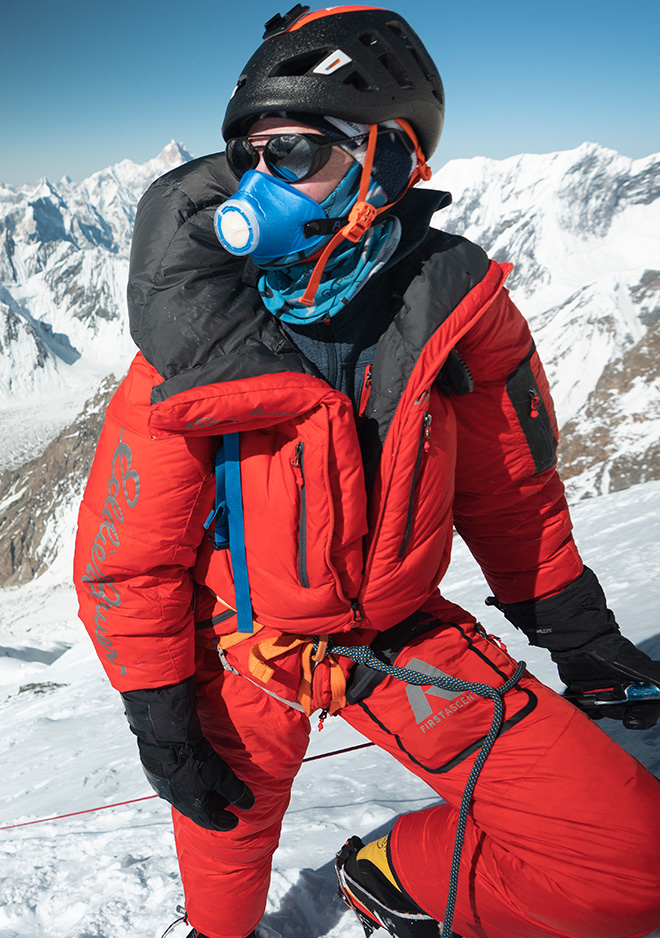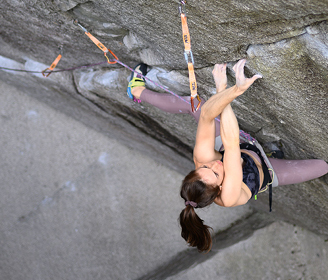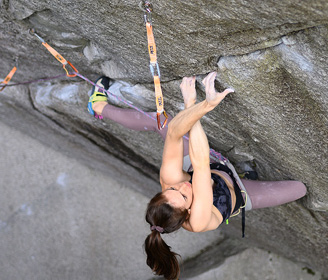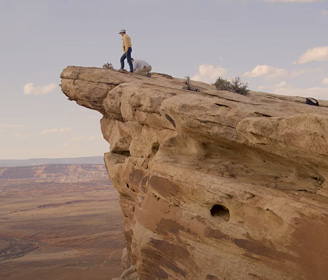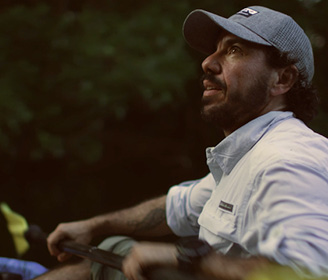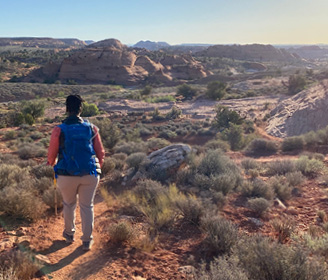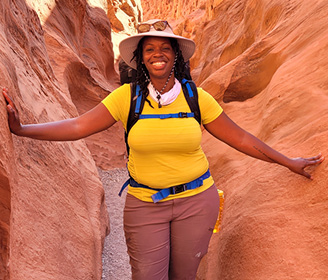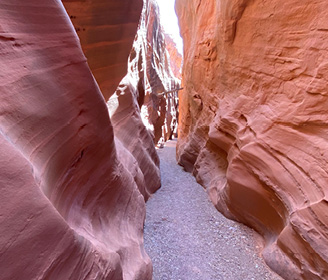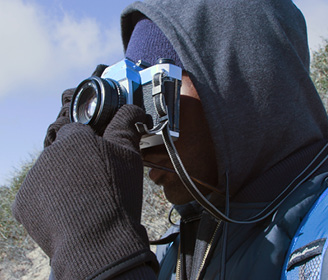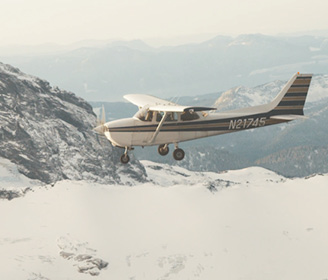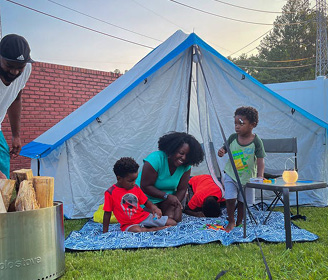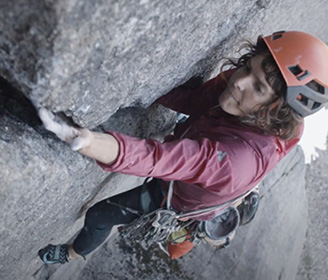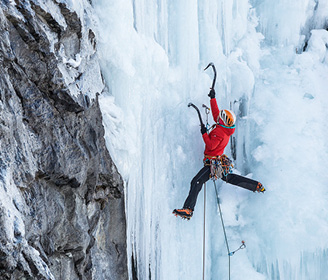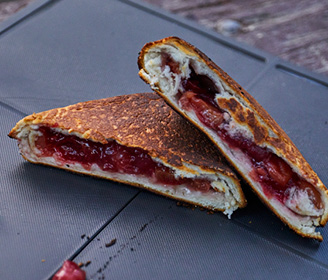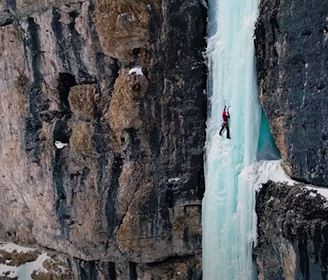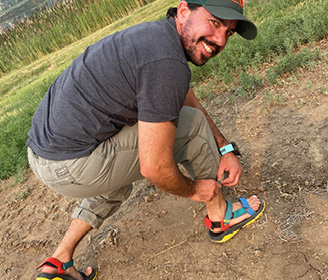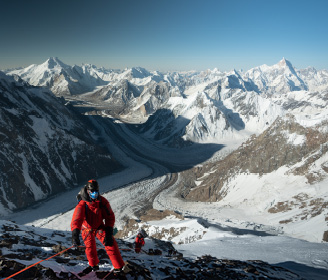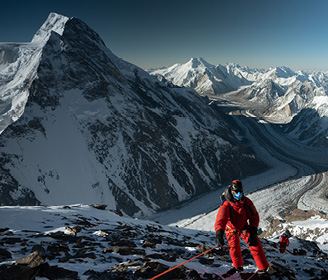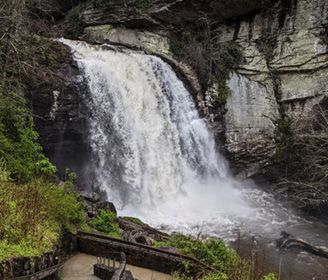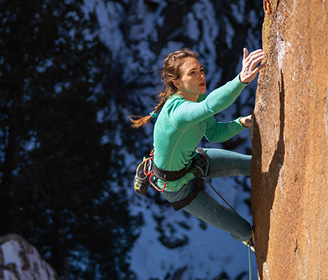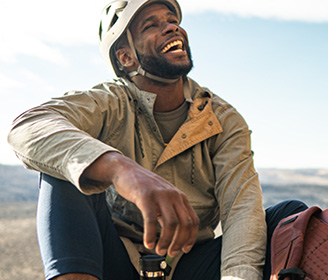Have you ever wondered how many 8000m peaks there are in the world and what it takes to summit an 8000m peak? Eddie Bauer Alpine Climbing Guide Adrian Ballinger, who has spent over 2 years combined on Mt. Everest answers the internet’s most asked questions about 800m peaks and what it takes to climb them.
Watch the video above!
Meet The team

ADRIAN BALLINGER
Eddie Bauer Alpine Climbing Guide (AMGA/IFMGA)
In his two decades as a professional guide, Adrian has led more than a hundred clients to the summits of several 8000-meter peaks, including Everest, Lhotse, Manaslu, and Cho Oyu. He’s personally summited Everest eight times.
We’re starting with an easy one. I appreciate that, Eddie Bauer and Google world.
How many 8,000-meter peaks are there?
There are 14 8,000-meter peaks. So what that means, that’s the 14 tallest mountains in the world. And 8,000 meters translates to about 26,000 feet in our system.
What’s the biggest difference between 8,000-meter peaks and other mountain climbs?
The extreme high altitude. 8,000-meter peaks, being so high, are at an altitude where the human body really isn’t getting enough oxygen to survive. So anytime you’re climbing on these mountains, especially without bottled oxygen, you’re kind of on borrowed time. Makes the climbing much more difficult and dangerous.
Which 8,000-meter peaks are the most difficult to climb?
You know, I think there are lots of different ways to look at that. I mean, Everest being the tallest and being at an altitude where truly most humans can’t physiologically survive without supplemental oxygen. So, that one, you know, Everest probably is the most difficult because of pure altitude. K2 is often considered the most dangerous or difficult. You know, it’s got a 20% fatality rate, the climb is extremely technical and difficult, it’s got this icefall and terrible weather, and so it’s often considered the most difficult. And then I actually think though it’s been surpassed by Annapurna as the most dangerous of the 8,000-meter peaks. Annapurna, I think, has almost a 30% fatality rate. So almost, you know, one in three or one in three and a half climbers who have summited have died, and so that is a really intense difficult 8,000-meter peak.
How much oxygen is in the air at 8,000 meters?
So it’s actually the same amount of oxygen as at sea level. The percentages are the same. What changes is how dense the gases are based on how much atmosphere is putting pressure on the air that you breathe, and so the density changes so the number of molecules you’ll take in of oxygen will be much less even though the percentages of oxygen versus nitrogen versus carbon dioxide are the same. Just to give a sense, at 18,000 feet, you have about 50% of the density or the atmosphere that you have at sea level, so half as much oxygen with each breath that you’ll take in. Once you get up to the summit of 8,000-meter peaks, you’re getting down in the range of 30% of the oxygen that you would have at sea level. And so that is what makes it so physiologically difficult to survive, nevermind actually climbing technical terrain to the summit of a big mountain.
What are good 8,000-meter peaks to start on?
So, great question. You know, first and foremost, 8,000 meters is 26,000 feet, and so it is not, you shouldn’t start there without years of experience on smaller mountains first. I recommend building experience by climbing, you know, at least four or five 6,000-meter peaks, so 20,000-foot peaks. So this could be in South America or in Asia. Then kind of graduating to 7,000-meter peaks and doing one or two 7,000-meter peaks like Aconcagua or Ojos del Salado, or even Ama Dablam if you love technical climbing, and then start to think about going to an 8,000-meter peak after you have 30 or more days in crampons, are really competent with winter camping, if handled big storms before. Things like that will really keep you safer on an 8,000-meter peak. Once you get to the point where you’re ready for an 8,000-meter peak, there’s really one that I recommend. It’s called Cho Oyu, it’s the sixth tallest mountain in the world. It sits on the border of Tibet and Nepal and it’s an incredible first 8,000-meter peak ’cause it’s tall, 8,201 meters, it’s super challenging but it doesn’t have a lot of uncontrollable hazard, it doesn’t have a lot of avalanche danger or icefalls, things that kill people randomly. And that’s where you wanna go to practice and learn all that skills and the high-altitude physiology of 8,000-meter peaks. So, check it out. Cho Oyu.
Which 8,000-meter peaks are the most technical?
K2 is usually considered the most technical. There is no easy route on K2. There’s no snow walking route. On every route on K2, you’re gonna climb a kind of like flying buttress of technical rock and ice, so two tool ice climbing or steep rock climbing with your hands and feet to finally get onto the summit plateau which takes you to the summit and is also still really dangerous and has a lot of avalanche hazard. So, K2, easily considered the most technical.
Do I need a guide on 8,000-meter peaks?
No, guides are in no way required on 8,000-meter peaks, but I wouldn’t recommend going and climbing an 8,000-meter peak without a certified guide if you haven’t spent years or decades building the experience necessary to make really difficult decisions around weather, avalanche conditions, snow conditions, and your own health. And so, a majority of people who go to these mountains do choose to hire mountain guides.
What’s the difference between 8,000-meter peaks and the Seven Summits?
They’re really very different with the only similarity being Everest is on both lists. So Everest is both one of the 8,000-meter peaks. It’s the tallest 8,000-meter peak. It’s also one of the Seven Summits. The Seven Summits is the tallest peak on each continent, makes up the Seven Summits. So, Everest is the tallest peak in Asia. A really small group that’s summited all 14 8,000-meter peaks and all of them, because of their extreme altitude, tend to be quite dangerous and take a lot of experience to accomplish. The Seven Summits actually have a wide variety of necessary experience or technical difficulty. So, one of the Seven Summits is Kilimanjaro, the tallest peak in Africa. It’s in Tanzania, 19,343 feet, I think? And despite being high, almost 20,000 feet, it’s non-technical. No glaciers, no ropes, no crampons, no ice axes. It’s a hike. And so, it’s a very attainable peak. It’s a peak that my company guides, I’ve guided 14 times, and it’s one of my favorite things in the world to guide because it’s like a gateway peak for people. Many people who have never climbed before, it’s their first mountain and it gives them a taste of what we love so much about high-altitude. So there’s quite non-technical peaks like that, but then there’s also peaks like Mount Vinson and Everest on the Seven Summits list, Vinson in Antarctica, Everest in Asia, and those peaks you need years of experience as a climber in order to safely ascend and be successful.
Why is bottled oxygen used on 8,000-meter climbs?
Great question. Because 8,000 meters is really high, 26,000 feet, where there’s much less atmosphere up there, and the human body needs oxygen to survive. If we were taken today from our altitudes where we live at, whether that’s me in Tahoe at 6,000 feet or you perhaps at sea level, or somewhere else in the world, if you were taken to 26,000 feet right now, to an 8,000-meter peak and dropped on the summit by a helicopter, you would live for a few minutes before being unconscious, comatose, and then dying. But really, at 8,000 meters, the human body can only survive for a matter of hours, even after acclimatizing for months. So you’re climbing, if you do climb above 8,000 meters, you’re trying to get up and down before it kills you and it’s really bad for your body and really dangerous. And so, climbing with supplemental or bottled oxygen makes it safer. It effectively lowers the altitude of the peak a bit, not a lot, but it effectively lowers it enough that the human body can stay warm, that your mind can still function and make decisions, and that you’re less likely to lose as many brain cells, so better in the long term. The vast majority of 8,000-meter peak climbing is done with supplemental oxygen, including almost all of our guiding at Alpenglow Expeditions, and it makes it much, much safer, and potentially you may enjoy the experience more and actually be able to remember it. I’ve summited Everest seven times with supplemental oxygen and remember those days vividly, and once without supplemental oxygen and remember almost nothing.
How does acclimatization work on 8,000-meter climbs?
You’re trying to get your body to build red blood cells. The more red blood cells we have, the more, like, little trucks we have for oxygen molecules from our lungs to bond to and then get carried to all of our muscles into our brain. Our brain is incredibly dependent on oxygen, it’s an oxygen hog. It needs a lot of it. So you need more red blood cells, more trucks, to move oxygen to the brain and the muscles. The only way to build those red blood cells is to stimulate your body to know that it needs more red blood cells. That’s done through the process of what we call acclimatization. The most common way, sort of the historical way to do that, is to go to a mountain, go to an altitude you’re comfortable at, then go higher on the mountain to where your body cannot survive or its very difficult for it to survive. That stresses the body, causes the body to release hormones that tells it to build more red blood cells, and then you drop down lower on the mountain to a place where you’re comfortable and can rest and recover and eat well. Let your body spend a few days building new red blood cells then go to a new higher altitude to stress your body, release those chemicals again, go back down to rest and recover and allow for more red blood cell building. That is the very non-technical, I am not a doctor or a scientist. Feel free in the comments to tell me how I did describing that process, but that is the process of acclimatization. There’s lots of other changes that happens, adjusting the pH of your blood, increasing your respiration and heart rate, sort of shorter term instant changes, but really the goal is building red blood cells.
What kind of gear do I need for 8,000-meter peaks?
It’s a great question. The system is no different than if you climb hills or mountains here in the United States or wherever you live. You need systems of layers that allow you to adjust for everything from warm temperatures to extreme cold and wet, soggy, rainy conditions to heavy snow. So, everything is about systems. So, layers of gloves from thin liner gloves to technical, like, leather gloves to big mittens. The same goes for our bodies. On my upper body, I might be wearing everything from a wool base layer, to a fleece middle layer, to a synthetic puffy jacket, to a down puffy jacket, to my big 8,000-meter down suit, the Peak XV suit. Same thing with my legs, four to five layers. So it does take a lot. If you do climb with a guide or a guide company like Alpenglow Expeditions, one of our big jobs is helping you in the months prior to the trip ensuring you get the best possible gear you can because it keeps you safer around the mountains to have the right gear, and it means you expend less energy than someone ill-equipped, and it’s all about reserving energy for the final summit push that helps us to be successful.
How to prepare for 8,000-meter climbs without supplemental oxygen?
So I’ve probably already touched on experience is the biggest thing that will help you to stay safe on 8,000-meter peaks with or without oxygen. On top of that is your actual physical training. I work with a company called Uphill Athlete. It’s really helped me to work on building my endurance base, on becoming what we call fat adapted, so relying on fat for my calories instead of carbohydrate calories at high altitude, which has made me a much more effective climber. And so, you know, there are lots of different coaching programs out there but, really, it’s gonna be a matter of years building endurance base for climbing 8,000-meter peaks without supplemental oxygen. You gotta love that process, too. If you don’t love the building experience and the training, then it will never be worthwhile. It’s just too much work.
Will my contact lenses freeze in my eye at over 8,000 meters?
This is actually a major issue. Eyes and people with eyesight issues have in the past really struggled at altitude because glasses are very difficult to wear under goggles and prescription lenses and sunglasses have been difficult to get in high enough quality. But no, many people do wear contact lenses on the mountains, always with a backup pair of glasses just in case it all goes wrong. You need to keep the contact lenses from not freezing when you’re not wearing them and so we actually sleep with them in our sleeping bags. Basically anything you don’t want to freeze on the mountain from your camera battery to your iPhone to your food for the next morning to your contact lenses and contact lens solution goes inside your sleeping bag while you’re sleeping so it doesn’t freeze in the intense cold temperatures at night. Kind of annoying, but absolutely necessary. And then when you have the contacts in your eyes, your eye actually keeps them warm, provided they’re not getting hit directly by the cold air and especially wind. So, contact users will generally wear goggles when it’s windy to stop all the wind. Sunglasses can sometimes be enough when it’s not super windy during the daytime. It’s a great question.
How many people have climbed all 14 of the 8,000-meters peaks?
That is a great question. I would bet somewhere around 20-ish people have climbed all 14 without supplemental oxygen, which is the style in which it’s really respected to climb all of the 8,000 meter-peaks. If that’s your goal, you’re probably gonna try to do it without oxygen. But I haven’t looked in a couple years. I’m gonna look up how many people have climbed all 14 8,000-meter peaks. So, according to Wikipedia, I was not even close. 43 people have climbed all 14 8,000-meter peaks, a few of those with oxygen, but I think most without. 43, double how many I thought. That’s incredible! So cool.
What skills do I need for 8,000-meter peak climbing?
Such a good question. You know, you need a variety of different mountaineering and climbing skills. You know, you want to build technical skills, things like rock climbing skills, ice climbing and crampon skills, and then rope work that’s applicable to high-altitude peaks, like crevasse to glaciers, and potentially technical climbing. And then you also want to build, like, what I would call, like, expeditions skills. So that’s like camp craft, being able to live in a tent, cook for yourself, survive big storms, read glaciers, know where to place camps, navigation in case of getting caught in storms, understanding weather. And that might all sound intimidating, it’s a lot of skills. The nice thing is you can build those skills by doing smaller peaks and experiencing all these different things, like surviving in a big storm in your tent, to be ready for 8,000-meter peaks.
How do you plan an 8,000-meter peak climbing trip?
You know, they are really complicated expeditions. They take years often to plan from scratch, and to fundraise for, and to have the right team for, and all the experience you need. So, the easy way is, of course, to hire a guide company. They do all the logistics and have the relationships in the country for all the local providers you need, the operators for running base camp, transportation, yaks, porters, things like that, and also have lots of experience dealing with the governments who manage these mountains, and sometimes the permit process can be really complicated in countries like Pakistan, Nepal, and China. But, you know, it is possible to plan from scratch without a guide company but you will still need a local logistics company in the country you’re climbing in. And I just really encourage you, someone who wanted to climb without a, you know, respected guide company, you really wanna do your homework to make sure you’re finding a local company that treats their staff fairly, pays them well, does things like removing human waste and trash from the mountain, sort of agrees to Leave No Trace ethics, and also fair work practices, and are gonna give you the safety net that you need when you’re climbing, whether that includes communications, or medical equipment, or backup oxygen, or staff, you really wanna know what you’re getting yourself into.
How cold does it get on 8,000-meter peaks?
Really, really cold. You know, it’s regularly minus 40 on 8,000-meter peaks on the summit, and there are regularly, you know, hundred plus mile per hour winds on 8,000-meter peaks. Now of course you can’t climb in those conditions, so you’re waiting for weather windows that are more accessible to humans. But even a good window on Everest is gonna be at least minus 20 degrees, and you’re probably gonna have 20 miles per hour wind. That would be a good summit day. So it can be brutally cold. The flipside is also true, though. When the sun is out and when there’s no wind at all and you’re on a glacier, it can get intensely intensely hot. Camp 2 on the south side of Mount Everest is famous for this at 21,000 feet where it turns into a complete solar oven with the sun bouncing off three walls of ice around you and the glacier below you and it can feel like it’s 150 degrees in your tent. Absolutely unbearably hot. So, you get a bit of everything. It’s a place of extremes.
How fit do I need to be to climb an 8,000-meter peak?
You need to be really fit. A marathon is one day long, and marathons are hard, but they’re one day. Maybe you run a marathon in three hours, maybe you run it in 10 hours, but it’s one day. On big 8,000-meter peaks, you need to put multiple days, like marathon days, back to back to back, and you need to be recovering or at least conserving enough energy to be able to get through day after day after day, and that takes a lot of fitness.
Are there age restrictions for 8,000-meter peaks?
Some countries like China are starting to set age restrictions. I think both China and Nepal now will not allow you to climb an 8,000-meter peak if you’re younger than 18. Back in the day, 10 years ago, those rules did not exist. And so, you know, I think there was a 13-year-old that climbed Mount Everest and summited, Jordan Romero, and maybe he was 15, and then a Nepali younger kid climbed. But so, quite young people have climbed the mountain, but I think a lot of people agree it’s quite dangerous. We don’t really know what extreme high altitude does in terms of physiology on growing bodies. And then now countries are starting to put in older age restrictions, at the upper end of the scale. But, I’ve guided an 82-year-old on Everest successfully back when that was allowed in Nepal, a Japanese climber. Now I believe the limit might be somewhere around 70 or 75. But it’s a big, big age range.
How do you go to the bathroom on 8,000-meter peaks?
This is actually the most popular question I get asked when I give slideshows. I don’t have to look this one up on Google. So, the key is Leave No Trace practices. Too many teams on the mountain, too many climbers don’t think about the next generation of climbers on the mountain and just go to the bathroom wherever they want. And the problem with that is actually snow doesn’t cover everything up and there’s no bacteria at high altitude to break down things like poop. So whatever you leave there, it’s gonna be there the next year and the next year and the next year, and climbing 8,000-meter peaks is only getting more popular, so it’s a real bummer. So, ethical guide companies use something called wag bags and they’re basically bags for being able to go number two and go poop in. So you basically poop in a big plastic bag. It’s got this special powder that astronauts use to make sure there’s no scent and to absorb all the liquid. And the good news is, up on these high mountains it all just freezes, then you carry it down and dispose of it below the kind of, like, grass line where bacteria will be around to break down the poop. The other important thing with that is the bags themselves are biodegradable. They’re made of corn so they break down so you’re not leaving loads of plastic down lower on the mountains. And then peeing, you know, you could pretty much pee anywhere, but generally we pee in pee bottles, whether we’re inside our tent. So, like, imagine a Nalgene bottle or a water bottle, a wide mouth water bottle, and we pee into that so you don’t have to get out of your tent when it’s negative 40 degrees to go outside and pee. You pee in your bottle, fill the bottle, and then go outside and dispose of it in a smart place well away from the camp. So, sounds kinda gross, but it’s actually really important for the mountain.
What’s the view like at 8,000 meters?
It’s just unbelievable, you know. It feels like you can see the curvature of the earth. If you’re climbing around a mountain between the border of Nepal and China, you can see out to the lowlands of Nepal that are really, like, jungly, and the plains, and you can see out the entire Tibetan Plateau, which is this high desert plateau that exists in Tibet, and of course you’re seeing just countless mountains, so many of which don’t even have names or haven’t been climbed yet. It is so, so inspiring. And as you can probably imagine, the stars are like completely mind-blowing because there’s no light pollution. It’s incredible, from base camp or from above 8,000 meters.
Why do people climb 8,000-meter peaks?
I think because of the challenge, because human beings are not meant to be there, and so it’s a true test to put together all the skills and experience and fitness and willingness to suffer to actually be successful up there. For me, personally, there’s a combination of physical challenge, mental challenge, like decision making, and emotional challenge of dealing with fear and dealing with suffering, and the combination of those three things, physical, mental, and emotional that I feel on 8,000-meter peaks is different than anything else I’ve ever done and I thrive on it. It provides a focus that I love and an intensity that I love, and it forces me to really depend on my team and my teammates who depend on me. And so I’ve made my closest and strongest relationships with people in the big mountains. 8,000 meters. You know, I’ve really dedicated my life, the last 25 years of my life to gaining the experience I needed to be able to go to 8,000-meter peaks, and then I’ve spent so much of the past 15 years climbing peaks like Cho Oyu, Everest, Makalu, Manaslu, Lhotse, K2, and it’s just one of my favorite things on this planet, of the tallest peaks in the world and the challenge they provide, and every year is so different that I never get bored of it. So, I just love it up there.

